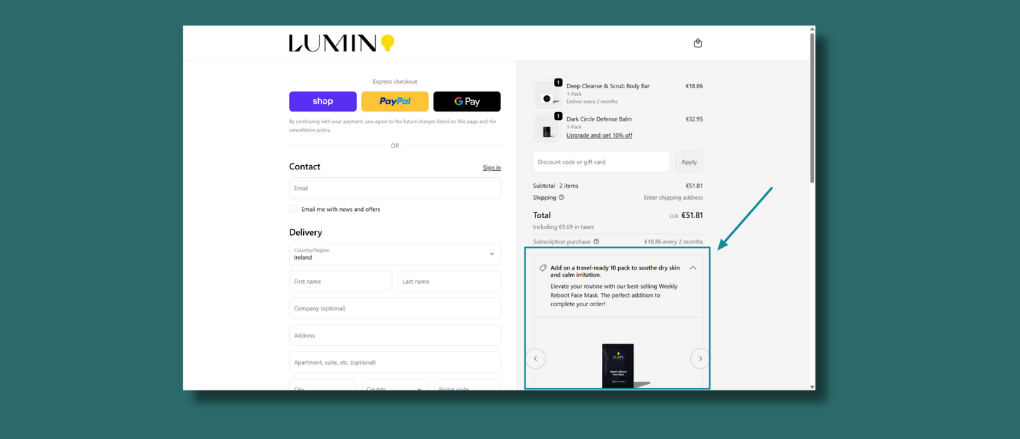18 Proven Upselling Tips to Boost AOV (With Examples)
.jpg)
The fastest way to grow your eCommerce store isn’t more traffic, it’s smarter upsells.
Think about it. You’ve already paid for the click and won the customer.
Now it’s time to maximize that order. With the right upselling tips, you can lift revenue by 10–30% on average, and do it without increasing ad spend.
Most stores don’t get this right.
Either they push irrelevant products, or they skip upselling entirely.
That’s why in this guide, we’re breaking down 18 proven strategies to increase average order value, improve customer lifetime value, and make every transaction more profitable.
Sounds good? Let’s jump in.
What is Upselling? (Definition + Quick Example)
Upselling is the practice of encouraging a customer to spend a little more by offering an upgrade, add-on, or complementary product.
The goal is simple: increase the order value while giving the customer something that makes their purchase better.
Think about Apple.
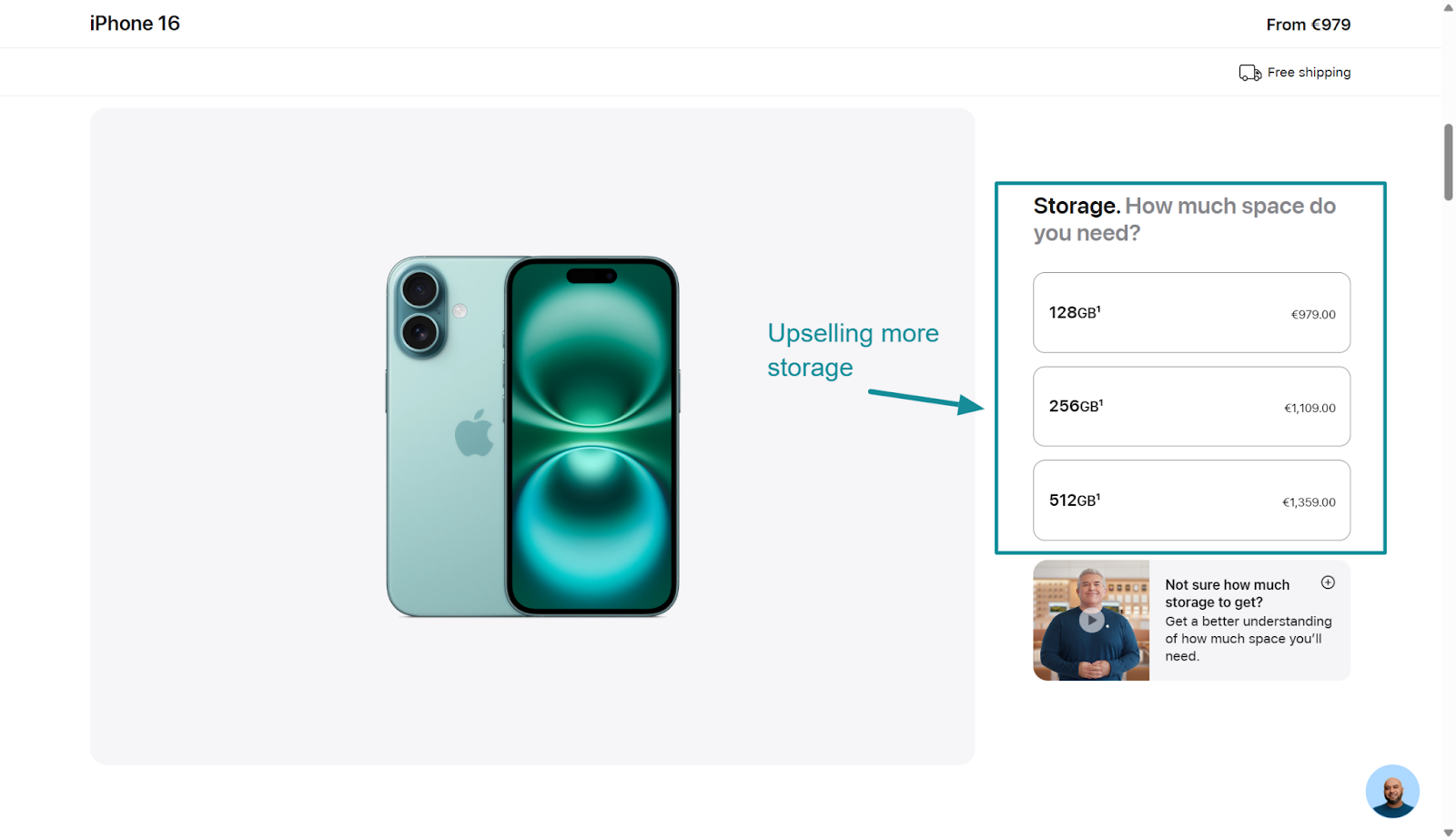
When you buy an iPhone, you often see the option to upgrade to a model with more storage.
It costs a bit extra, but it solves a real problem and makes the purchase more valuable for the customer. That is a textbook upsell.
For ecommerce stores, upselling is one of the most effective ways to drive growth without raising acquisition costs.
Instead of chasing new traffic, you are maximizing the value of the customers who already trust you enough to buy.
Why Upselling Matters for Your Ecommerce Store
Acquiring new customers is expensive.
Between ad spend, content, and discounts, most stores barely break even on the first purchase.
That is why upselling is so powerful.
Instead of pouring more money into acquisition, you increase the value of every order that is already in motion.
Research shows the probability of selling to an existing customer is 60 to 70 percent, while the chance of selling to a new customer is only 5 to 20 percent.
This makes upselling one of the highest ROI activities in ecommerce.
It boosts average order value, drives repeat sales, and improves lifetime value without raising your marketing budget.
Upsells also improve the customer experience when done right.
Shoppers get upgrades, bundles, or add-ons that make their purchase more useful or enjoyable.
This is not about pushing random products.
It is about anticipating what customers actually want and serving it at the perfect moment.
When you do that, everyone wins.
Upselling Tips: 9 Principles of Effective Upselling
Now that you know what upselling is and why it matters, let’s jump right into the tips that’ll help you start upselling successfully today
1. Always Start with Relevance
Relevance is what separates a successful upsell from an annoying distraction.
The offer should clearly improve or enhance the product the customer is already considering.
Take Sage coffee machines as an example.
When a shopper views the Luxe Brewer priced at €299.90, they are shown the Sage Precision Brewer for €329.90.
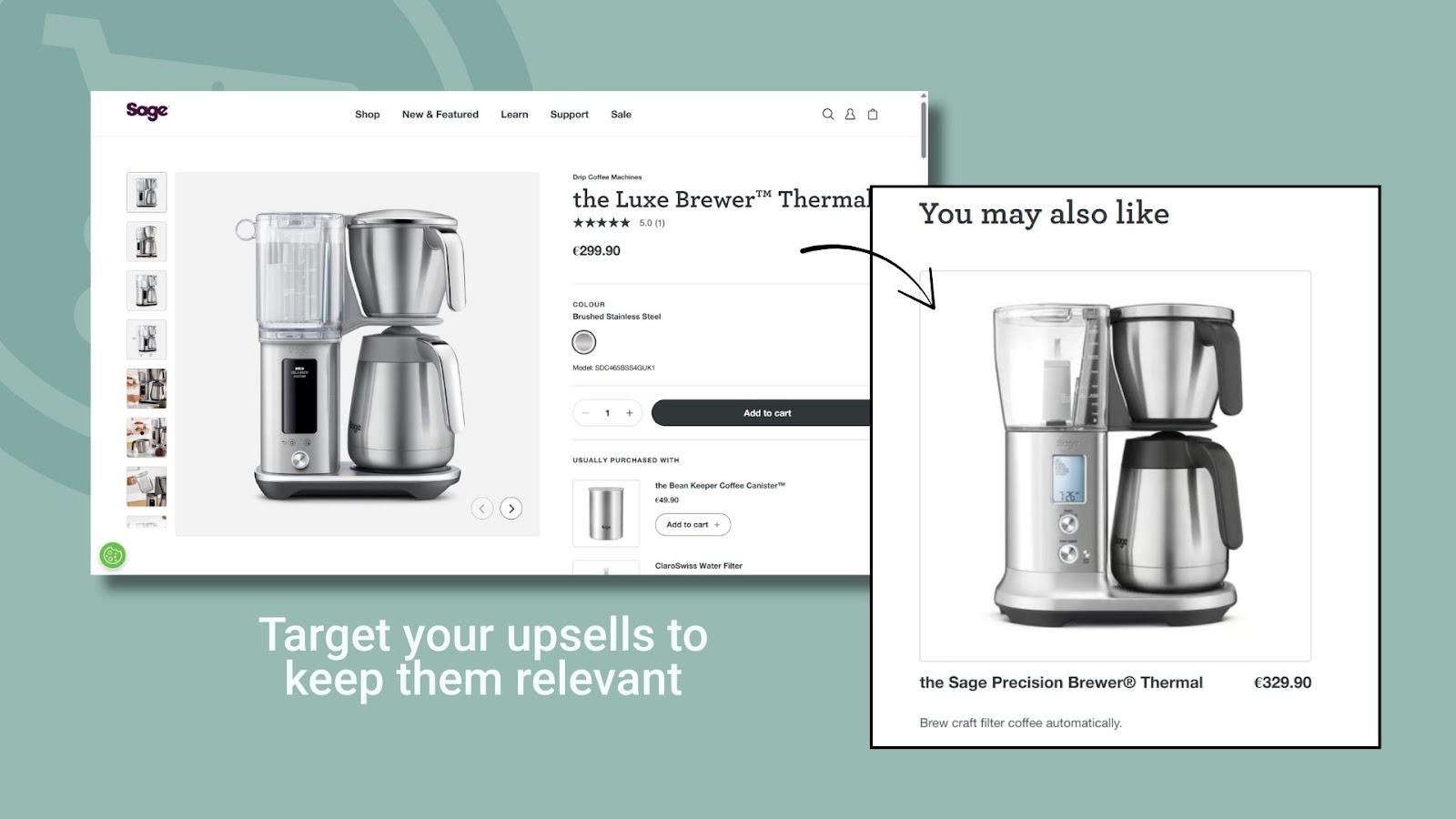
It is the same core product, a drip coffee machine, but with more advanced features.
For just €30 more, the customer gets a better version of what they already wanted.
That is relevant because it solves the same need, fits the same buying context, and feels like a natural upgrade.
If the upsell were something unrelated, like a toaster or a blender, it would feel out of place and risk breaking the flow.
The key is simple: does the upsell make the original purchase better?
If yes, you are adding value for the customer as well as for your business.
2. Choose the Right Price Point
Even the best upsell will flop if the price feels off.
As a rule of thumb, an upsell should cost about 20 to 30 percent of the original product price.
That range is high enough to make a meaningful impact on your average order value, but not so high that it creates sticker shock.
Think about someone buying a $100 pair of shoes.
Offering a $10-30 more premium shoe feels like a reasonable offer.

But trying to upsell them on a $250 pair of shoes instead of the $100 pair the same time won’t work. It’s just too far above budget.
The sweet spot is where the customer barely hesitates before saying yes.
For maximum conversions, you want the upsell to feel like an easy decision. Not a new major purchase that needs consideration..
Ecommerce brands that follow this guideline tend to see better conversion rates and less cart abandonment, while still getting a healthy boost in AOV.
3. Choose the Right Time to Introduce the Upsell
Timing is everything in upselling.
Show the offer too early and you risk distracting the customer from completing their first purchase.
Show it too late and you miss the moment of the highest buying intent.
The ideal time depends on the product and the customer journey.
Here are five proven placements that consistently work in ecommerce (more on each one later):
- Product page: introduce an upgraded version or bundle before the shopper adds the item to their cart.
- Cart page or drawer: surface add-ons or small upgrades right before checkout, when the customer is reviewing their order.
- One-click upsells: present an easy yes-or-no offer immediately after the payment step, so the buyer can add it with no friction.
- Thank you page or order confirmation: turn this often-overlooked page into a sales driver by offering loyalty rewards, bundles, or complementary upgrades.
- Email post-purchase: follow up with a personalized email upsell after the order is complete, when the buyer has already shown trust in your brand.
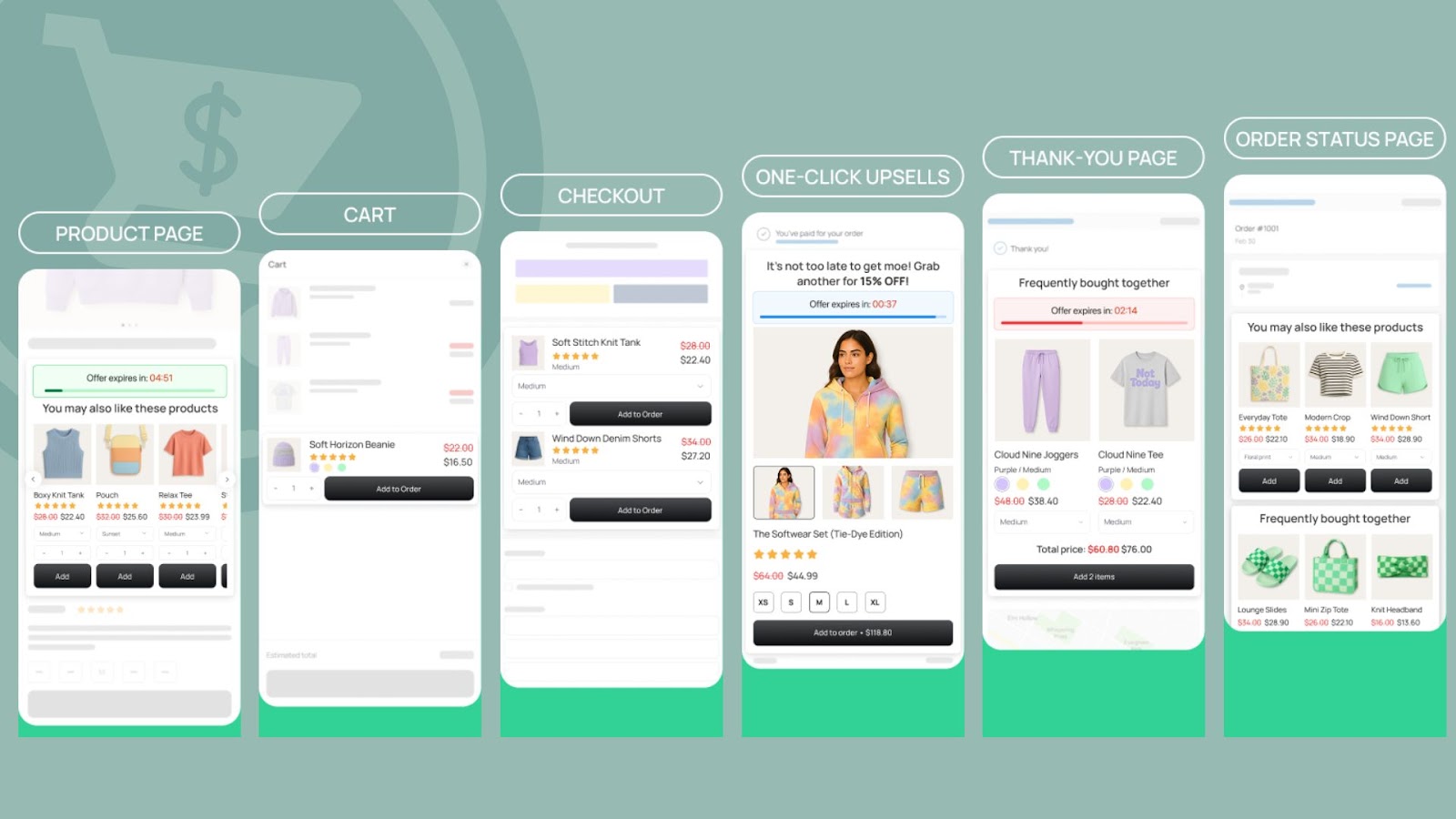
Each touchpoint is an opportunity to maximize value without interrupting the buying flow.
4. Don’t Be Pushy
Even the most relevant upsell can backfire if it feels aggressive.
Most customers will say no to an upsell, and that is normal.
In fact, even strong upsells only convert at around 10-12% percent of the time.
That means the majority of shoppers will decline, and the experience still needs to feel smooth and respectful.
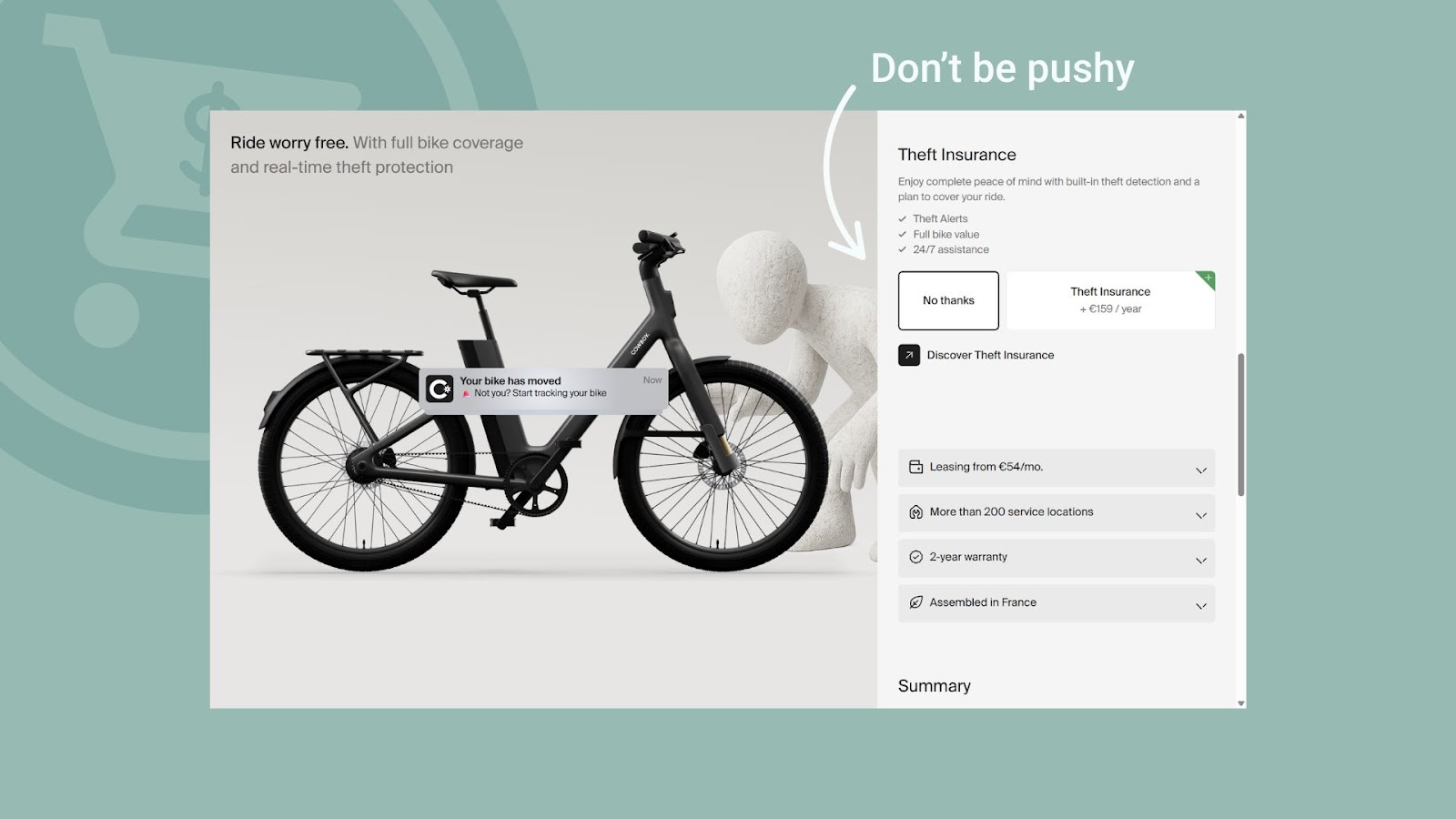
If the upsell is hard to close or interrupts the purchase flow, it risks frustrating the customer and hurting your overall conversion rate.
The goal is to make the upsell easy to accept, but just as easy to dismiss.
Think of it as an invitation rather than a demand.
When customers feel in control, they are more likely to engage with the offer and more likely to come back to buy again.
5. Personalize Upsells
Generic upsells rarely perform well.
Shoppers are more likely to say yes when the offer feels tailored to their needs, preferences, or behavior.
Personalization can be as simple as using purchase history to recommend relevant upgrades, or as advanced as segmenting by customer location, demographics, or browsing habits.
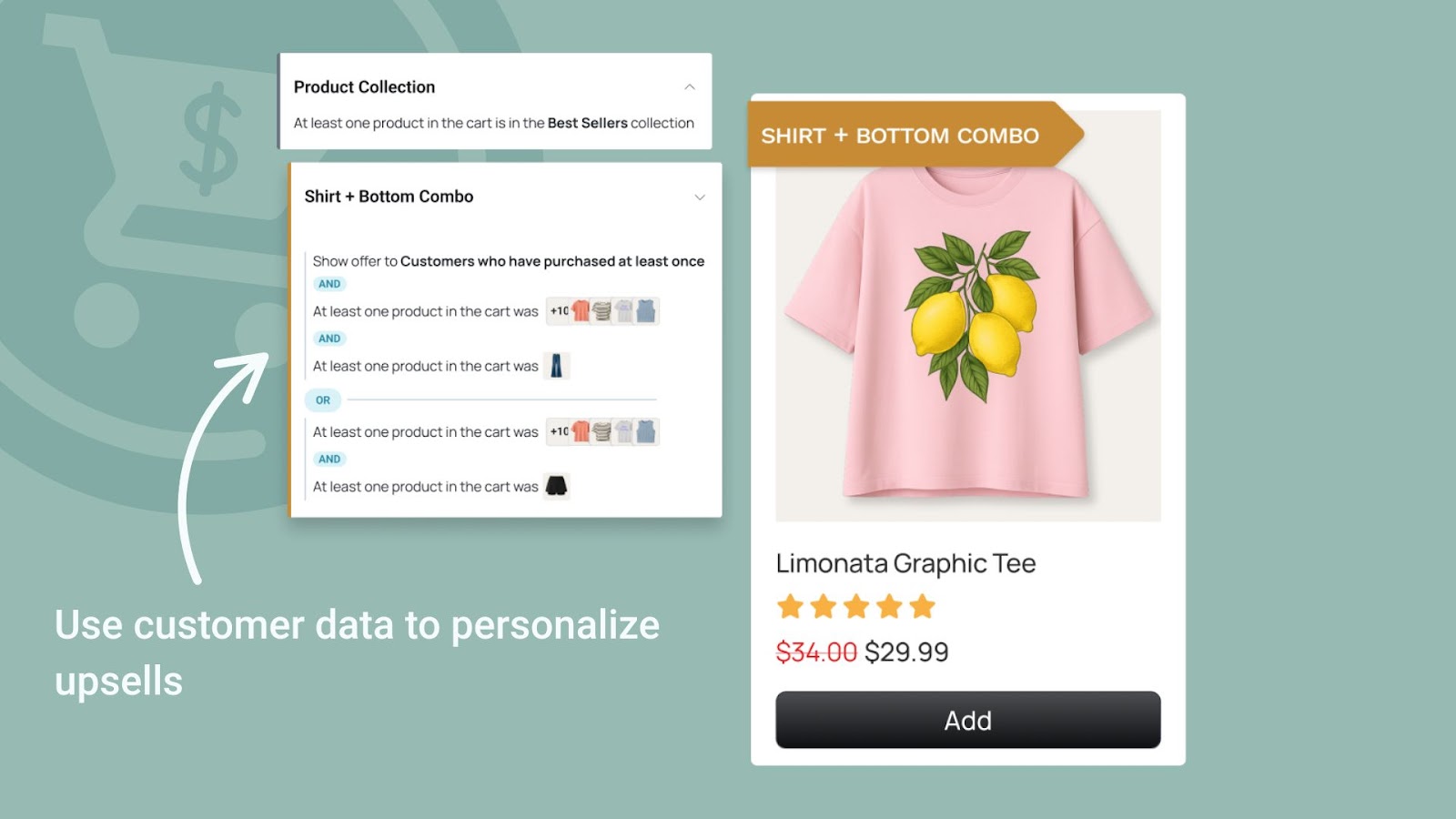
For example, an ecommerce store selling apparel might show winter gear as an upsell only to customers in colder climates.
A beauty brand could offer refills or larger sizes to customers who have already purchased a certain product line.
The key is to align the upsell with what you know about the shopper, so it feels like a thoughtful suggestion rather than a random pitch.
Personalized upsells not only increase acceptance rates but also strengthen brand loyalty by showing customers you understand them.
6. Use Urgency and Exclusivity
Upsells work best when they feel special and time-sensitive.
If the offer is always available, shoppers have no reason to act now.
Urgency creates momentum and helps customers make a decision in the moment.
One way to do this is by framing the upsell as exclusive to the current purchase.
For example, “Add this upgrade now and save 15 percent - offer only valid with this order.”
Another approach is using subtle scarcity signals, like a low stock warning or a limited-time countdown timer.

A small, discreet timer at checkout can remind customers that the deal expires soon without creating panic or pressure.
The goal is to motivate action while keeping the customer experience positive and trustworthy.
Handled well, urgency and exclusivity turn a nice-to-have offer into an irresistible deal.
7. Add Social Proof
Customers feel more confident accepting an upsell when they see that others have done the same.
Social proof reduces hesitation by showing that the offer is trusted, popular, and worth the extra spend.
This can take the form of customer reviews, star ratings, or a simple “Bestseller” tag next to the upsell.
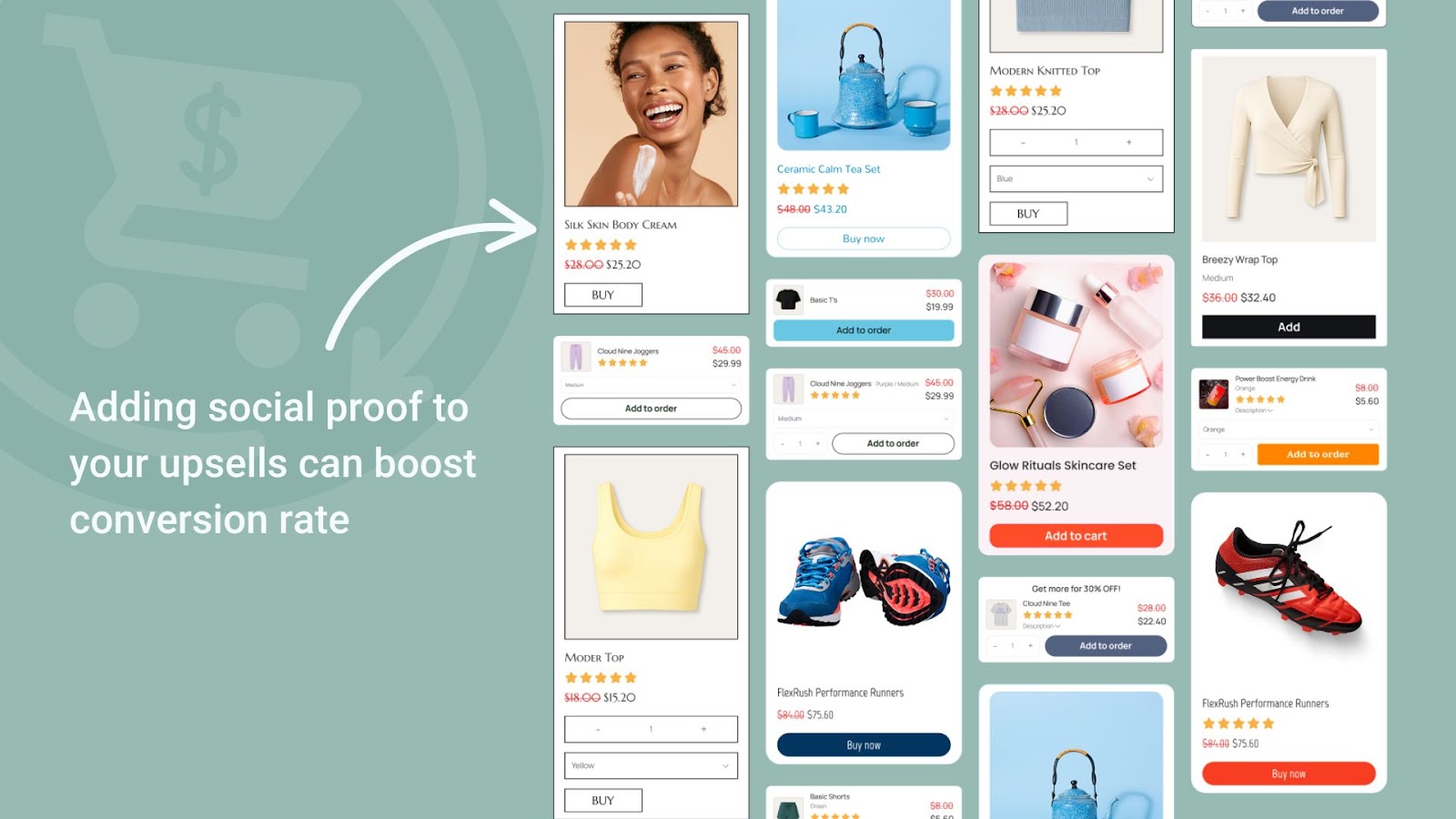
For example, a supplement brand might highlight that the larger bottle size is their most popular option.
An electronics store could showcase a testimonial about how much easier life is with the upgraded version of the product.
Even subtle cues like “2,321 customers added this to their order last month” can push customers toward a yes.
The key is to make the upsell feel safe, validated, and backed by real experiences.
8. Limit the Options (Rule of 3)
Too much choice can kill an upsell.
When customers see too many offers at once, they freeze and often choose nothing at all.
The solution is to limit the upsell options to no more than three.
This “rule of 3” keeps the decision simple while still giving the customer a sense of choice.
For example, Gymshark uses a ‘Get the look’ box on product pages - presenting the 3 other items of clothing in the product image.
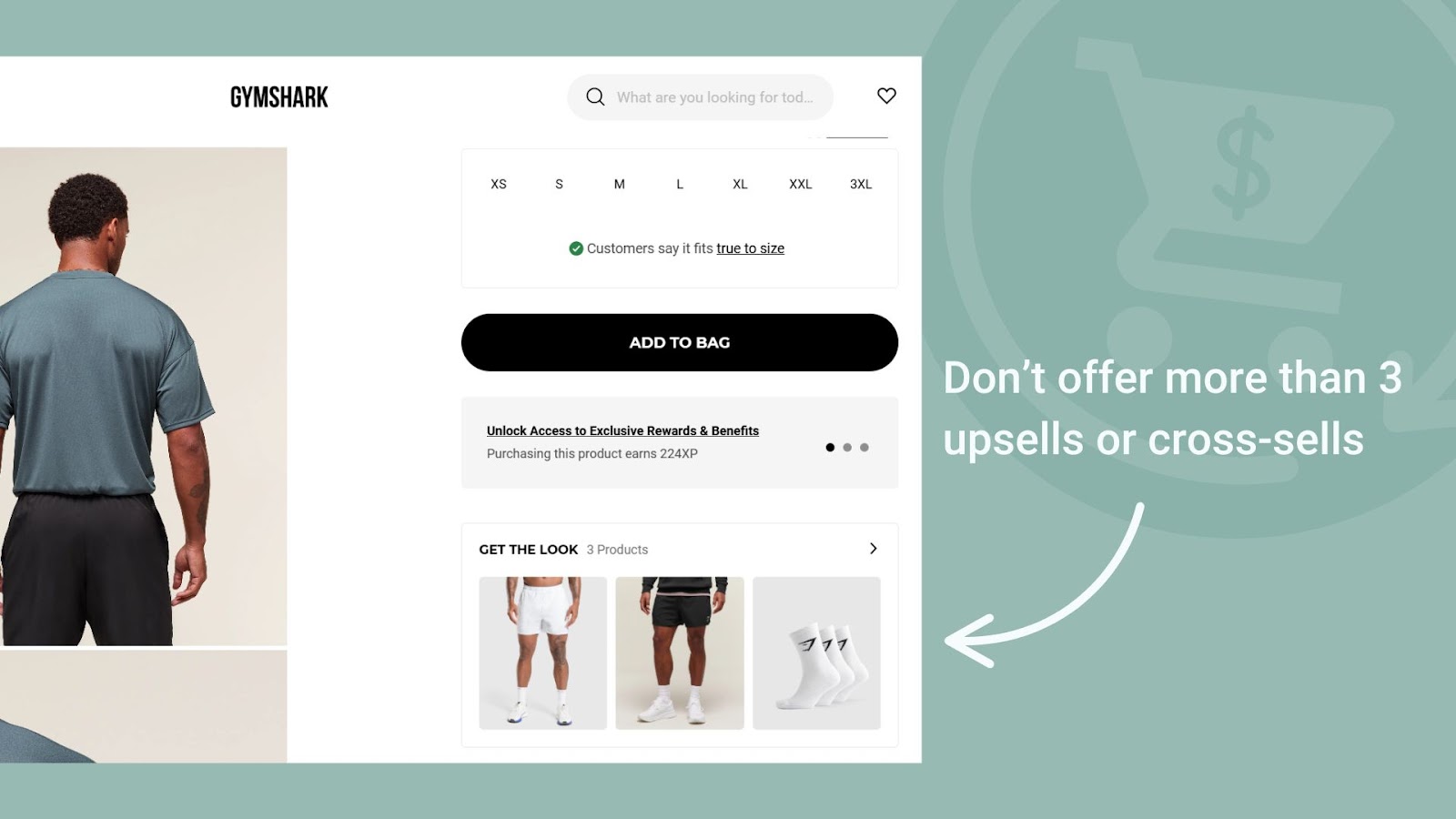
That way, customers see clear, distinct options without feeling overwhelmed.
Less is more in upselling, and the goal is clarity, not clutter.
When the choices are easy to compare, customers are far more likely to pick one.
9. Focus on Customer Value Over Profit
The best upsells are framed around customer benefit, not your margins.
If the offer feels like a cash grab, shoppers will say no and may even lose trust in your brand.
Instead, position the upsell as a way for customers to get more value from their purchase.
This could be saving money with a bundle, improving performance with an upgraded version, or protecting their investment with insurance.
For example, a skincare brand might offer a complete set at a discounted rate compared to buying each item individually.
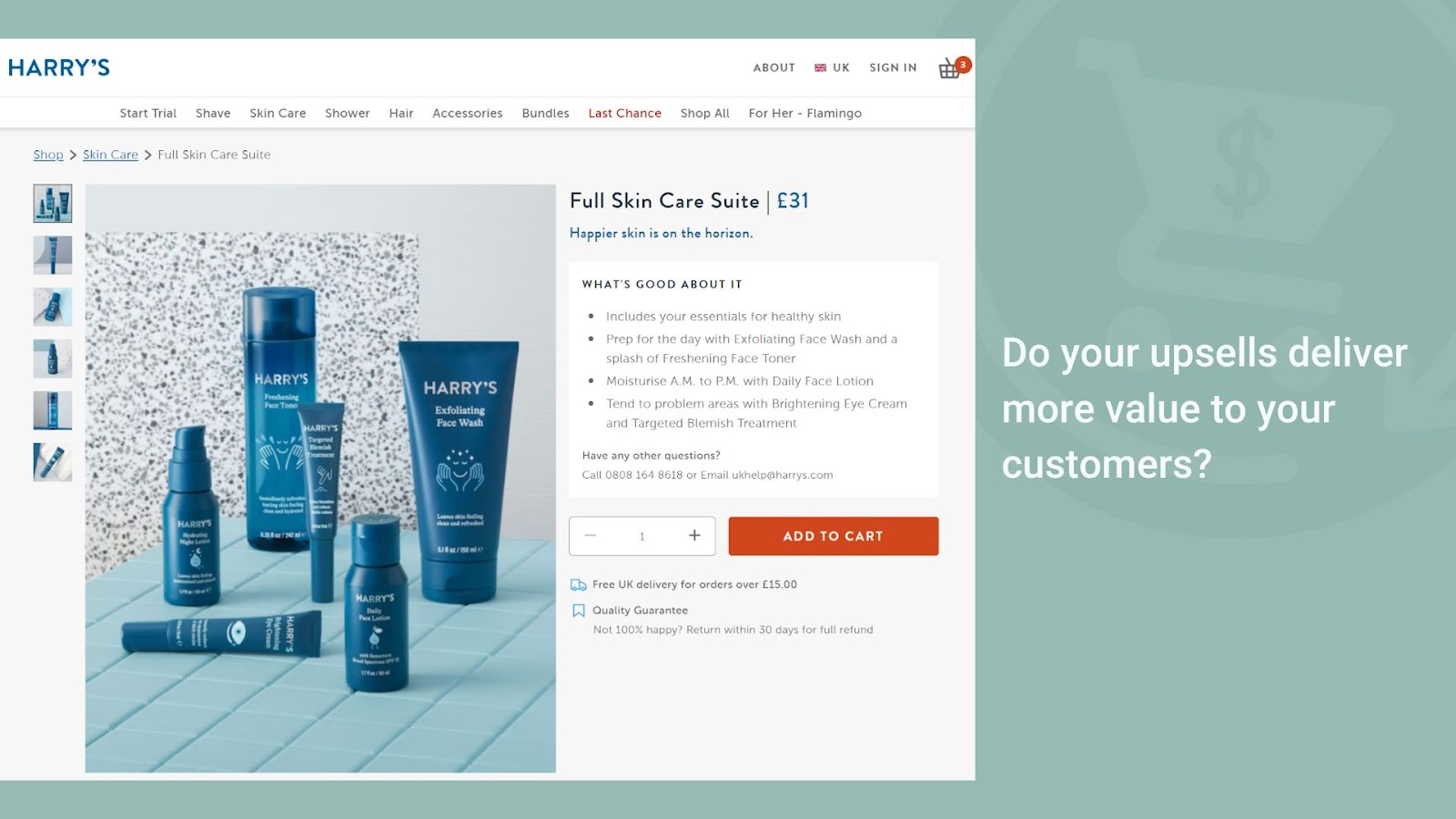
The customer feels like they are getting a deal, and you still increase your average order value.
When customers believe the upsell helps them, they are far more likely to accept it.
Upselling Tips: 4 Types of Upsells That Work
Upselling works best when you understand the different ways to present added value.
Not every upsell looks the same, and the format you choose should fit both your product line and your customers.
10. The version upgrade
The most common upsell form. It encourages customers to move to a higher tier of the same product. Here’s a quick product page upsell example I made with ReConvert.
.jpg)
11. Product protection
Another powerful option. This includes shipping insurance, theft coverage, or accident protection, which gives customers peace of mind at checkout.
.jpg)
12. Service add-ons and customization
These take upselling beyond the product itself. A Subscription, an extended warranty, installation service, or a personalized engraving all create extra value while increasing margins.
.jpg)
13. Bundles
Combine complementary products or offer volume discounts. A skincare set, a meal kit, or a buy-three-get-one-free offer all fall into this category. Here you can see how Bruvi created a discounted bundle that includes everything shoppers need to get started.
.jpg)
Understanding these upsell types is the foundation for building offers that feel natural and increase order value without harming the customer experience.
Upselling Tips: 4 Proven Strategies That Scale
At this stage, the basics are in place.
To unlock the next level of growth, you need tools that let you upsell seamlessly across the entire customer journey.
This is where platforms like ReConvert come in.
ReConvert makes it easy for eCommerce stores to add one-click upsells, optimize the thank-you page, and even collect customer data like birthdays to drive future offers.
Here are five advanced, proven strategies that our users leverage to scale their AOV & revenue.
14. Upsell Low-Ticket Products at Checkout
Checkout is the perfect moment to add small, low-cost items that improve the order.
These should be products customers can say yes to instantly, without thinking too hard about price.
Many ReConvert users have success with shipping insurance, gift wrapping, or digital products like extended guides.
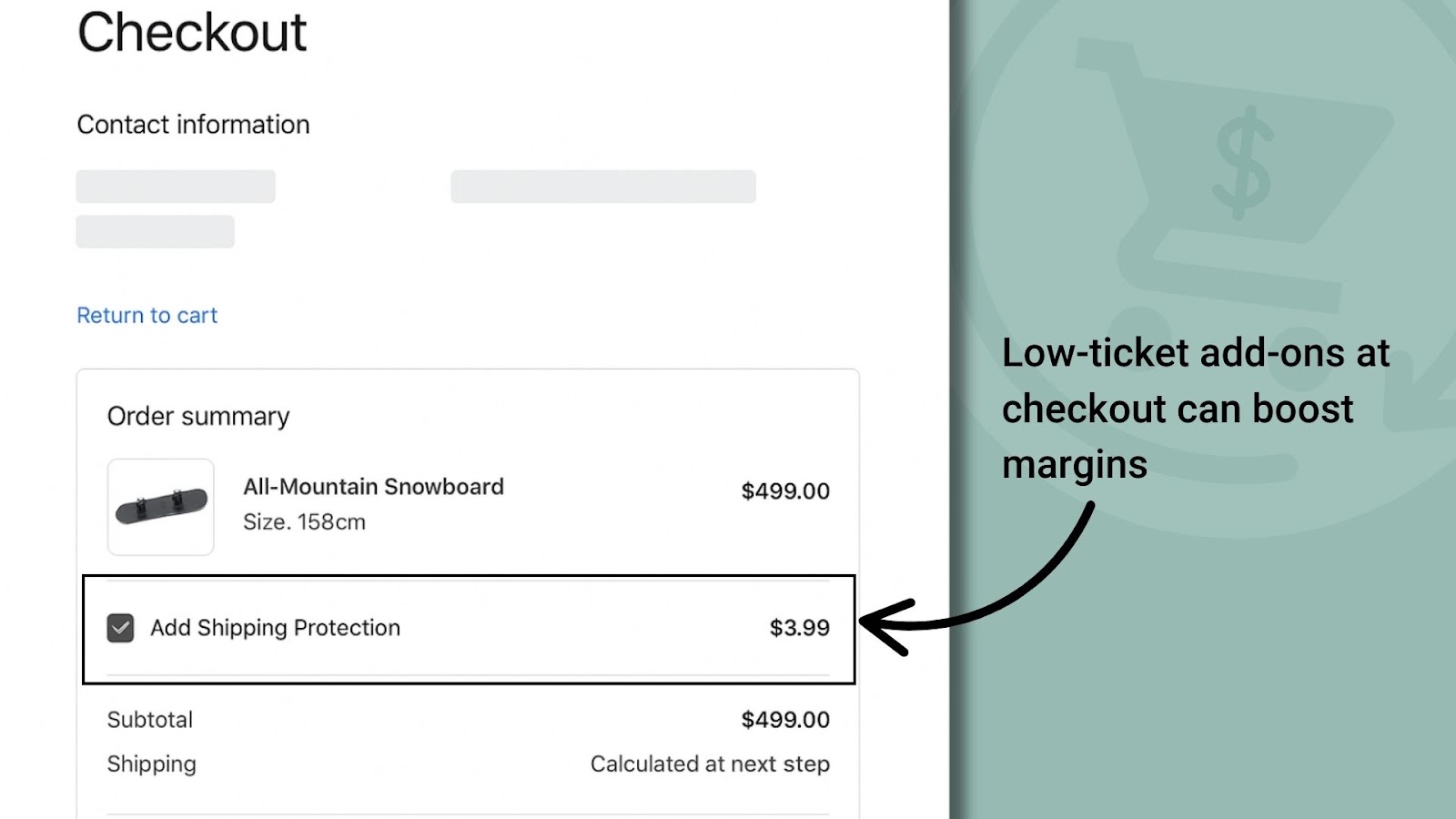
Checkout upsells work because price is low, the value is clear, and the customer is already ready to pay.
15. Master Post-Purchase One-Click Upsells
Most ecommerce stores stop selling once the payment is complete.
That is a missed opportunity, because the customer is in a buying mindset and already trusts your brand.
A post-purchase one-click upsell lets you present a new offer immediately after checkout, without requiring the customer to re-enter payment details.
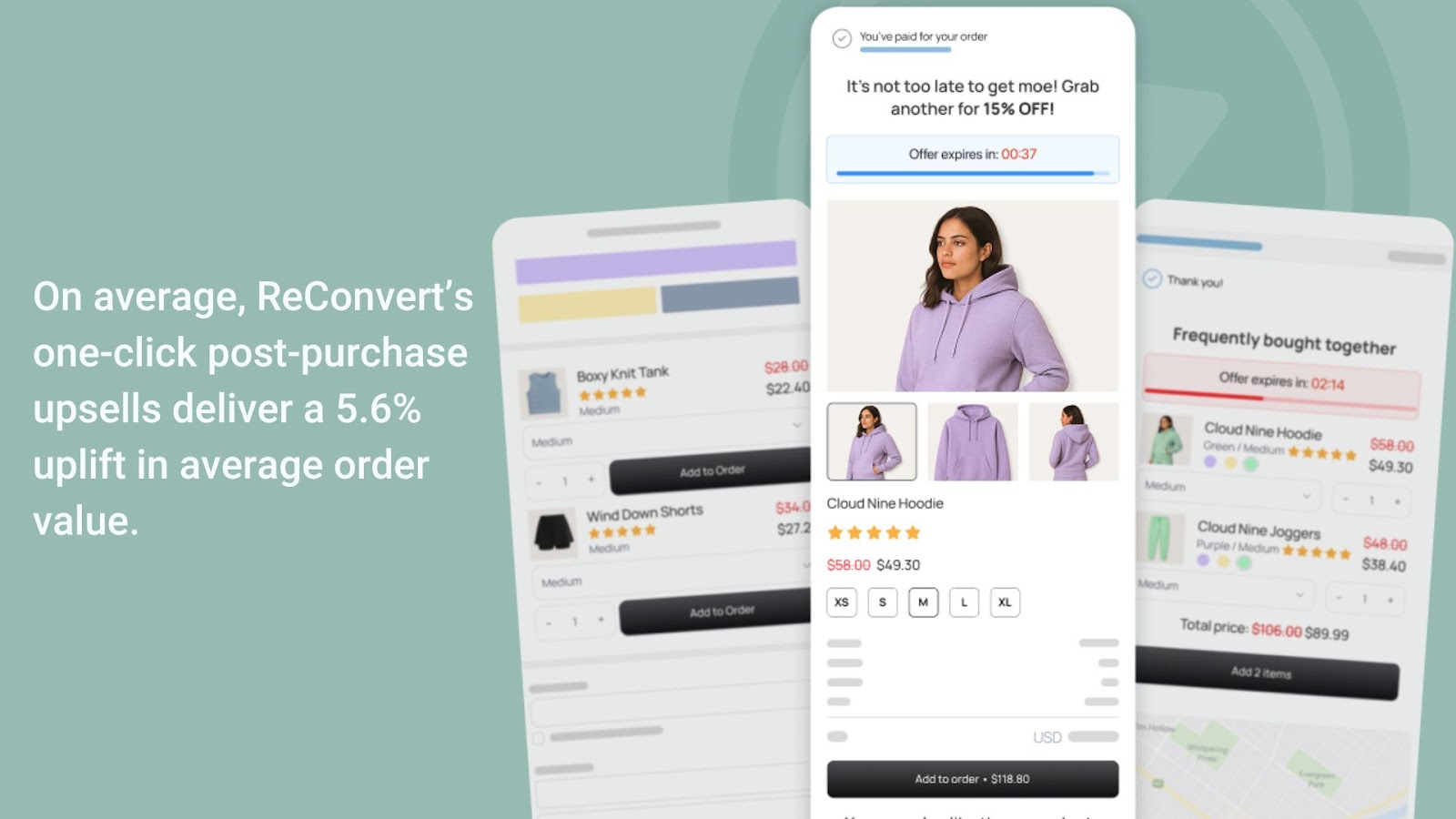
The friction is gone, which makes the offer easy to accept.
For example, a supplement brand might show a “double your order for 20 percent off” offer right after the customer pays.
Since the transaction is already closed, the upsell feels like a bonus rather than a disruption.
This tactic works especially well for consumables, accessories, impulse-friendly products, and volume discounts..
The key is to keep the upsell simple, relevant, and time-sensitive.
📖Suggested Reading: How Olivia Jewelry Unlocked an Extra $138,678 With Post-Purchase Upsells
16. Leverage Thank-You Page Upsells
The thank-you page is one of the most underutilized assets in ecommerce.
Most stores treat it as the end of the transaction, but it can actually be the beginning of a new one.
When customers land on this page, they are still in buying mode and paying close attention.
That makes it the perfect place to present an upsell that feels like a natural continuation of their purchase.
For example, you could showcase complementary accessories, offer a discount on a related product, or invite customers to join a loyalty program.
Many ReConvert users transform their thank-you page into a revenue driver by adding dynamic upsells that match the order.

The key is to keep the layout clean and the offers simple, so the customer feels guided rather than bombarded.
Handled right, the thank-you page becomes a hidden sales channel that builds stronger relationships and drives repeat revenue.
“Thank you page cross selling provides incredible value - many merchants don't realize how many times their customers see their thank you page. The impressions are crazy - two, three, even up to four times per order is standard. When you think about it, that’s more impressions than any other part of the funnel - so optimization is non-negotiable”
Jacob Elbaum, CEO of Shivook, eCommerce CRO agency
📖Suggested Reading: How Tushy used thank you page cross-sells to generate an extra $191,786/mo.
17. Collect Birthdays to Upsell Customers Later
Upsells don’t have to happen only at the moment of purchase.
One smart strategy is to collect customer birthdays and use them to trigger personalized offers later on.
Birthdays are natural buying occasions, and customers are more open to treating themselves or accepting a special deal.
For example, you could send a “Happy Birthday” email with a discount on their favorite product, or offer a free gift if they place an order during their birthday month.
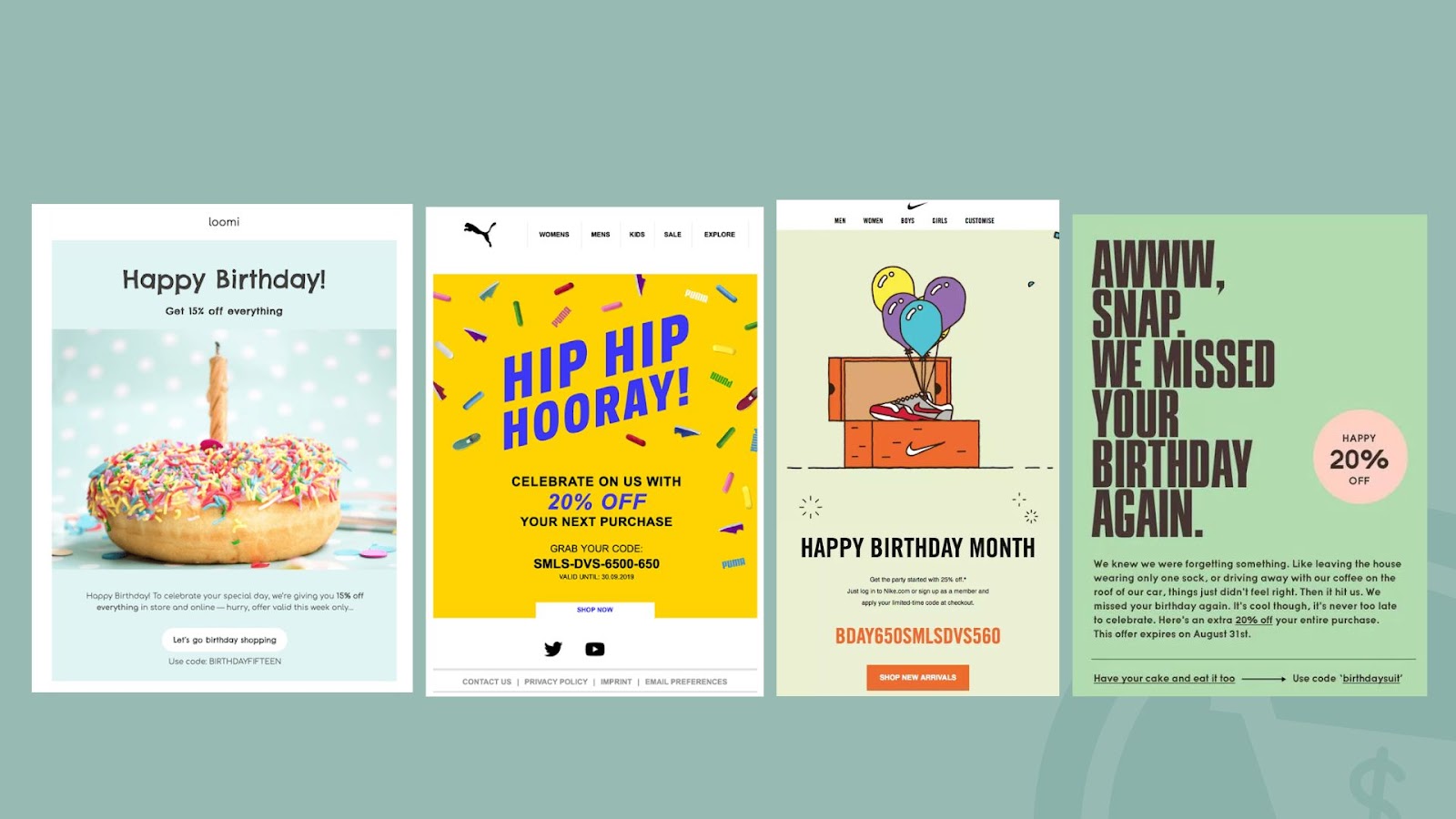
ReConvert makes this simple with a built-in birthday collector that can be placed on the thank-you page or order confirmation page.
It feels like a small touch, but it gives you a powerful piece of data to drive timely upsells and create a stronger connection with your customers.
This approach keeps your brand top of mind, adds a personal element to your marketing, and turns birthdays into reliable revenue drivers.
📖Suggested Reading: How Ave Estelle generated £7,268+ in 30 days from a simple birthday email automation
{{cool-component="/style"}}
Use These Upsell Tips to Grow Your Sales Today!
Upselling is one of the fastest and most reliable ways to grow ecommerce revenue.
It doesn’t require more traffic, bigger ad budgets, or new customer acquisition.
It’s about making the most of the customers you already have by offering them more value at the right time.
Here are the key takeaways from this guide:
- Relevance is everything. An upsell only works if it makes the original purchase better.
- Price matters. Keep upsells in the 20–30 percent range to maximize acceptance.
- Timing is critical. Use product pages, checkout, thank-you pages, and even post-purchase emails strategically.
- Keep it customer-first. Upsells should feel like a service, not a sales trick.
- Use proven formats. Version upgrades, product protection, service add-ons, customization, and bundles all work when executed well.
- Scale with tools. Platforms like ReConvert make advanced upselling strategies seamless, from one-click offers to thank-you page optimization.
The bottom line is simple: upselling isn’t about squeezing more money out of customers.
It’s about helping them get the most from your products while unlocking hidden revenue for your business.
If you’re ready to implement these upselling tips, grow your average order value and customer lifetime value, try ReConvert free today





.jpg)

